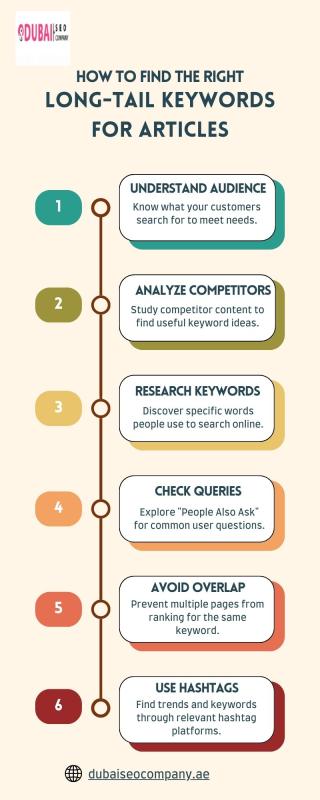How to Choose the Perfect Long Tail Keywords for Your Articles

Using the right long tail keywords is a smart way to attract more traffic to your website or blog. These keywords are longer and more specific phrases that users search for. By targeting them, you can create content that matches what your audience is looking for. In this guide, we’ll explain how to choose the perfect long-tail keywords for your articles.
Understanding Long-Tail Keywords
Long-tail keywords are phrases that typically contain three or more words. Unlike single keywords, they are detailed and specific. For example, instead of “shoes,” a long-tail keyword would be “comfortable running shoes for women.”
These keywords often reflect the exact terms people type into search engines, especially when they have a specific goal in mind. By targeting these phrases, you cater to an audience that is more likely to convert or take action.
Long-tail keywords usually have lower search volumes but higher relevance. This makes them essential for driving quality traffic to your website and improving your rankings.
Why are Long-Tail Keywords Important for SEO?
Long-tail keywords are crucial for search engine optimization (SEO) because they:
- Target Specific Audiences: They allow you to reach users with clear intentions.
- Lower Competition: Fewer businesses compete for long-tail keywords, making it easier to rank.
- Higher Conversion Rates: Users searching with specific terms are often ready to take action.
- Match Voice Search Queries: With more people using voice search, long-tail phrases match how they naturally ask questions.
By focusing on long-tail keywords, you can create personalized content that ranks better and drives more meaningful traffic.
How to Find Long-Tail Keywords
Finding the right long-tail keywords requires research and tools. Here are the steps you should follow:
Understand Your Audience
Start by understanding your target audience. What are they searching for? What problems are they trying to solve?
- Use Surveys or Feedback: Ask your audience directly through surveys or feedback forms.
- Check Forums: Platforms like Reddit or Quora often show the exact questions people are asking.
- Identify Pain Points: Analyze your audience’s challenges and tailor your keywords around solutions.
By putting yourself in your audience’s shoes, you can identify long-tail keywords that match their intent.
Use Autocomplete
Autocomplete is a simple but powerful tool.
- Google Autocomplete: Start typing a keyword in Google, and it will suggest popular searches related to your phrase.
- YouTube Autocomplete: Works the same way and is helpful if your content includes videos.
- E-commerce Autocomplete: If your niche involves products, check autocomplete suggestions on platforms like Amazon.
These suggestions are real searches users make, giving you direct insight into their behavior.
Analyse Competitor Content
Competitors can be a great source of inspiration.
- Review Top Articles: Look at the content ranking for your target keywords.
- Find Gaps: Identify areas they’ve missed and cover those in your articles.
- Use Tools: Tools like SEMrush or Ahrefs can analyze competitors’ keyword strategies.
By learning from competitors, you can improve your keyword selection and outrank them.
Use Keyword Research Tools
Keyword research tools simplify finding long-tail keywords.
- Google Keyword Planner: Shows search volume and competition levels.
- Ahrefs and SEMrush: Provide detailed analysis and variations of keywords.
- AnswerThePublic: Focuses on questions and phrases users commonly search for.
These tools can uncover long-tail keywords you might not think of on your own.
Check People Also Ask Boxes
Google’s “People Also Ask” boxes are a goldmine for long-tail keywords.
- Search Your Topic: Look at the related questions listed in these boxes.
- Expand Questions: Clicking on a question generates more related queries.
- Use as Subheadings: Turn these questions into subheadings for your content.
This feature provides real-world queries that can help structure your articles.
Go for Cannibalisation
Keyword cannibalization happens when multiple pages target the same keyword.
- Identify Duplicate Keywords: Use tools like SEMrush to find cannibalized terms.
- Create Long-Tail Variations: Modify these keywords to make them more specific.
- Update Content: Ensure each page has a unique focus to avoid overlap.
This strategy ensures all your content works together to improve your SEO.
Leverage Hashtag Sites
Hashtag websites like Hashtagify or RiteTag can inspire long-tail keywords.
- Enter Your Topic: Search for your niche to find trending hashtags.
- Check Related Tags: Related hashtags often suggest new keyword ideas.
- Use Them in Articles: Incorporate these as part of your long-tail strategy.
These platforms are particularly useful for social media and content promotion.
Go for Variations
Variations of keywords allow you to expand your reach.
- Use Synonyms: For example, “buy affordable shoes” and “purchase cheap footwear.”
- Different Forms: Try plurals, verb forms, or regional variations.
- Think Locally: Add city or region names for localized keywords.
Variations ensure your content reaches a broader audience while staying relevant.
Bonus Subheadings for Long-Tail Keyword Research
Use Question-Based Keywords
Question-based keywords align with search queries like “how to,” “what is,” or “why.”
- Answer Common Questions: Address user questions directly in your content.
- Use FAQs: Include a FAQ section targeting these keywords.
- Target Voice Search: These keywords work well for voice-activated searches.
Consider Seasonal Keywords
Some keywords are more relevant during specific times of the year.
- Plan Content Around Seasons: For example, “best winter coats for kids.”
- Use Google Trends: Find seasonal variations of keywords.
- Update Content: Refresh old posts to match seasonal demand.
Use Content Gap Analysis
Content gaps reveal opportunities in your niche.
- Analyze Competitors: Identify topics they haven’t covered.
- Fill the Gap: Write in-depth articles addressing these gaps.
- Use Tools: Platforms like SEMrush highlight missing keywords.
Optimize for Long-Tail Keywords in Titles and Meta Descriptions
Include your long-tail keywords in:
- Title Tags: Ensure your main long-tail keyword appears in the title.
- Meta Descriptions: Add keywords naturally to encourage clicks.
- Headings and Subheadings: Use them strategically to structure your article.
Combine Keywords
Combine multiple long-tail keywords to target a broader audience.
- Create Lists: Group related keywords.
- Write Comprehensive Articles: Address all grouped keywords in one piece.
- Boost Rankings: Combining keywords can improve rankings for multiple terms.
By following these strategies and subheadings, you can effectively choose the perfect long-tail keywords for your articles. This will improve your SEO performance, attract the right audience, and help your content succeed in search engine rankings.


Comments